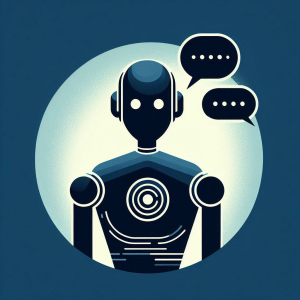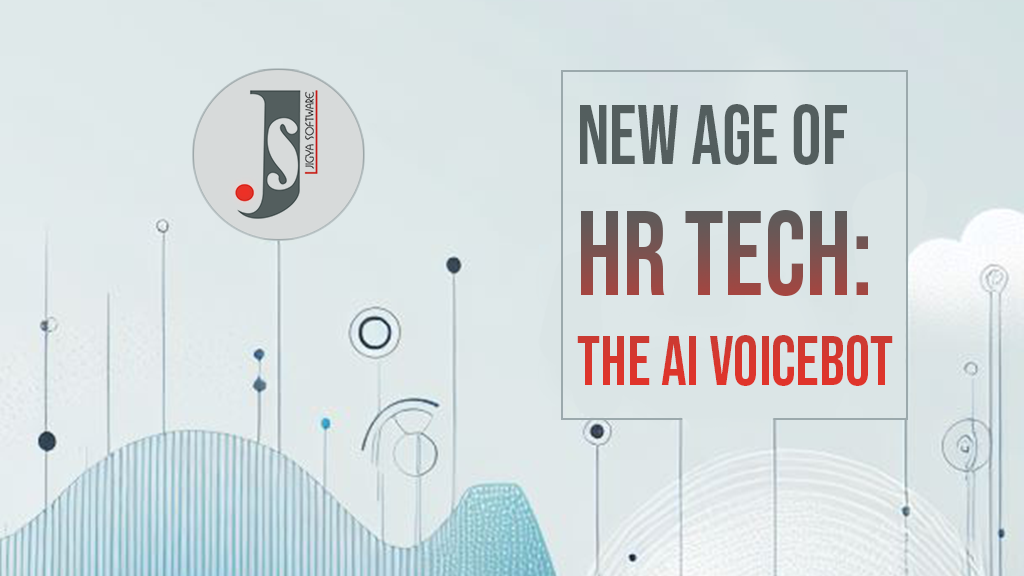The HR Tech industry is undergoing a period of significant transformation. As HR professionals grapple with the challenges of an ever-competitive talent landscape, innovative technological solutions are emerging to streamline processes and enhance candidate experiences. At Jigya Software Services, a leading provider of recruitment process outsourcing (RPO), software solutions, and technology consultancy services, we’re at the forefront of this evolution. We firmly believe that Artificial Intelligence (AI) plays a pivotal role in building a robust recruitment strategy, and one of the most exciting advancements in this domain is the integration of voice bots. This blog talks in details about Voice bots and their role in the Recruitment Industry, Key Functionalities and Challenges that the future holds for this novel technology.
A Brief Intro about Voice bots
Voice bots, also known as conversational user interfaces (CUIs) or virtual assistants, are software applications powered by AI that enable natural language interaction. Leveraging Natural Language Understanding (NLU) and Natural Language Processing (NLP) technologies, these intelligent agents can comprehend spoken language, interpret user intent, and generate tailored responses. Voice bots can be seamlessly integrated into various websites, platforms, and applications, offering users a convenient and intuitive experience.
Traditionally, recruitment processes often rely on Interactive Voice Response (IVR) systems that require users to navigate menus and select options using keypad inputs. Voice bots represent a significant leap forward in HR Tech, allowing candidates to engage in a more natural, conversational interaction. Imagine a scenario where a potential applicant seeking information about a job opening at your company can simply converse with a voice bot on your website. The bot, equipped with a comprehensive understanding of the role and company culture, can answer questions about responsibilities, benefits, and the application process. This not only empowers candidates with readily available information but also frees up valuable time for HR teams who can focus on more strategic aspects of recruitment.
More than just an Interviewer
The impact of voice bots extends beyond initial candidate engagement. These AI-powered assistants can also be employed for pre-screening purposes. By conducting short voice assessments that evaluate skills, experience, and suitability for the role, voice bots can significantly reduce the time and resources required for shortlisting qualified candidates. This translates to a more efficient talent acquisition process and allows HR teams to prioritize interactions with the most promising applicants.
In the following sections, we’ll delve deeper into the multifaceted applications of this revolutionary HR Tech in recruitment and explore how Jigya’s comprehensive HR solutions, coupled with cutting-edge AI technology, can empower your organization to build a competitive advantage in the talent marketplace.

HOW DOES VOICE BOT WORK IN RECRUITMENT
Let’s delve into the fascinating interplay of various AI subfields that bring voice bots to life.
The journey begins with Natural Language Understanding (NLU), a branch of AI that empowers voice bots to comprehend the spoken word. NLU, sometimes referred to as Spoken Language Understanding (SLU), utilizes advanced algorithms to decipher the meaning behind spoken phrases, even when faced with complex requests or multiple inquiries strung together in a single sentence. Alternatively, some systems leverage Speech-to-Text (STT) technology to first transcribe the spoken input into written text, which is then analyzed for deeper understanding.
Once the voice bot grasps the core meaning of the user’s query, often referred to as “intent,” it leverages sophisticated AI mechanisms to compare it against a vast knowledge base of existing cases. This enables the bot to identify the most relevant and helpful response for the specific situation. To ensure maximum effectiveness, voice bots are typically pre-trained on domain-specific data, allowing them to tailor their responses to the unique context of your recruitment process. Additionally, the bot may query company databases to retrieve customer-related information, such as account details or past interactions, further personalizing the experience. The latest generation of AI-powered voice bots takes this a step further by employing a form of machine learning called “reinforcement learning.” Through trial and error, these advanced bots can continually refine their responses, striving to deliver the most optimal interactions over time.
Text-to-Speech (TTS)
Finally, the voice bot utilizes Text-to-Speech (TTS) technology, also known as speech synthesis, to vocalize the crafted response. Modern TTS engines have reached a level of sophistication where the synthesized speech is nearly indistinguishable from a real human voice. Throughout this entire process, the voice bot operates with minimal, near-imperceptible delays, creating a seamless and natural conversational experience for the user, akin to interacting with a live representative.
KEY RECRUITMENT FUNCTIONALITIES OF VOICE BOTS
Let’s explore the key functionalities that empower voice bots to seamlessly navigate interactions and elevate the recruitment experience for both candidates and HR teams.
1. Intent Analysis: Decoding the Meaning Behind the Words
Arguably the most critical feature is Intent Analysis, the bot’s ability to grasp the underlying meaning within a spoken phrase. Human communication is rarely literal, filled with nuances and conversational quirks. A sophisticated voice bot leverages Intent Analysis to bridge this gap, accurately interpreting the essence behind a candidate’s words.
For instance, a simple “sure” or “why not” often translates to an affirmative response, while “I’m good” or “not really” might imply a polite decline. These seemingly basic examples highlight the intricate nature of voice bot communication. As HR departments increasingly rely on automation to streamline workflows, ensuring clear and accurate communication becomes critical. For voice bots to successfully transition into this role, they must possess the intelligence to discern crucial details like:
- Reaching the Right Person: Verifying if they’ve connected with the intended candidate.
- Sentiment Analysis: Understanding the candidate’s emotional tone and tailoring responses accordingly – whether it’s scheduling a follow-up call or transferring the interaction to a live recruiter.
Here are illustrative scenarios showcasing these functionalities in action:
-
Scenario 1: Unavailable Candidate
Voice Bot: “Hello, this call is regarding your application for the [Job Title] position. May I speak with [Candidate Name]?”
(Silence or brief response followed by a disconnect)
In this scenario, the voice bot intelligently recognizes the candidate’s unavailability (e.g., hanging up quickly) and avoids further disruption. A well-programmed bot would politely thank the individual and schedule a follow-up call for a more convenient time, demonstrating respect for the candidate’s time.
-
Scenario 2: Multi-Step Responses
Voice Bot: “Hello, this call is regarding your application for the [Job Title] position. May I speak with [Candidate Name]?”
Candidate: “[Candidate Name] speaking. I’m a bit busy right now. Can you call me back in the evening?”
Here, the voice bot must grasp a multi-step response without prompting further clarification.
2. The Art of Active Listening: Balancing Pauses and Clarity
As highlighted by Intent Analysis, the bar for AI-powered assistants like voice bots is constantly rising. While active listening allows the bot to determine next steps or pause during a candidate’s response, it’s equally important for the bot to clearly communicate its purpose.
For example, voice bots are often used to convey vital information or remind candidates of deadlines. A well-designed bot would be programmed to deliver critical information uninterrupted, even if faced with a brief pause or interruption. This ensures the candidate grasps the call’s objective clearly.
It’s important to remember that AI-powered voice bots are valuable additions to the recruitment process, not replacements for human interaction. Complex negotiations, sensitive conversations, or calming irate candidates are best handled by experienced recruiters.
In the following sections, we’ll delve deeper into additional features that enhance the functionality and user experience of voice bots within the recruitment domain. We’ll explore advancements in areas like real-time speech recognition, personalization, seamless transitions to live agents, and continuous AI-powered learning, all designed to empower Jigya’s comprehensive HR solutions and propel your organization towards a future-proof recruitment strategy.

Ways in Which AI Voicebots are Improving Recruiting
The recruitment landscape is undergoing a continuous evolution, driven by technological advancements and a relentless focus on efficiency and candidate experience. At Jigya (https://www.jigya.com], a leading provider of recruitment process outsourcing (RPO), software solutions, and technology consultancy services, we’re at the forefront of these trends. One of the most exciting innovations transforming the recruitment process is the integration of AI-powered voice bots.
These intelligent virtual assistants offer many benefits, streamlining workflows, enhancing candidate engagement, and empowering HR teams to focus on strategic initiatives. Let’s delve into the compelling ways AI voice bots are revolutionizing recruitment:
1. Streamlining Repetitive Tasks:
One of the most significant advantages of voice bots lies in their ability to automate repetitive administrative tasks. These virtual assistants can be programmed to handle a wide range of duties, including scheduling interviews, sending personalized messages to candidates, and fielding basic inquiries. By alleviating HR professionals from these time-consuming activities, voice bots free up valuable resources that can be directed towards more strategic aspects of the recruitment process, such as building relationships with top talent and crafting compelling job descriptions.
2. Harnessing the Power of Natural Communication:
Humans are inherently social creatures, and voice communication is often our preferred mode of interaction. Research indicates that information retention is significantly higher through listening compared to reading. In the recruitment context, this translates to a more natural and engaging experience for candidates. AI voice bots can deliver job descriptions, answer frequently asked questions, and even conduct initial screenings – all through a conversational format that feels more human-like compared to traditional text-based interactions on a website.
3. Fostering Stronger Candidate Engagement:
Building strong relationships with potential hires is crucial for attracting and retaining top talent. Voice bots play a vital role in fostering improved candidate engagement throughout the recruitment process. By offering a readily accessible communication channel and facilitating a more natural conversational flow, voice bots create a more positive candidate experience. This translates into higher application rates and a wider pool of qualified talent for your organization to consider.
4. Elevating the Candidate Experience:
In today’s competitive talent market, providing a positive candidate experience is paramount. The impersonal nature of traditional hiring processes can often deter qualified individuals. AI voice bots address this concern by injecting a degree of personalization into the early stages of recruitment. By tailoring interactions based on candidate responses and leveraging Natural Language Processing (NLP) to understand intent, voice bots create a more engaging and welcoming environment for potential hires.
5. Aligning with Modern Communication Preferences:
The digital revolution has fundamentally altered the way we communicate. Smartphones and voice-activated devices are ubiquitous, and voice notes are increasingly replacing text messages. This shift in communication preferences extends to the recruitment landscape as well. By incorporating voice bots into your recruitment strategy, you’re aligning with the way many candidates prefer to interact, ultimately making the application process smoother and more convenient.
6. Boosting Response Rates:
Throughout the recruitment process, from initial outreach to interview scheduling and onboarding, a significant amount of information exchange occurs. Traditional text-based communication methods can often lead to lower response rates from candidates. However, voice bots offer a more engaging and interactive format, leading to measurably higher response rates. This translates to a wider pool of qualified candidates for your consideration.
7. Embracing the Rise of Voice-Based Hiring:
Voice-based hiring is a rapidly growing trend that streamlines the remote recruitment process. This innovative approach is particularly well-suited for geographically dispersed teams and talent pools. AI-powered voice bots provide a convenient and efficient platform for conducting initial screenings and interviews, making remote hiring a viable and effective strategy for organizations of all sizes.
8. Building Trust Through Human-Like Connection:
While chatbots offer a basic level of automation, they often lack the ability to create a genuine human-like connection. Voice bots, on the other hand, can be customized with a recruiter’s voice and tone, fostering a sense of credibility and emotional connection with potential hires. This personalized approach helps build trust and rapport early on in the recruitment process.
9. Leveraging AI for Efficiency and Accuracy:
The recruitment process traditionally involves significant challenges in identifying and sourcing qualified candidates with the right skill sets. The introduction of voice bots powered by AI and NLP has dramatically improved the efficiency and accuracy of this critical function. By leveraging sophisticated algorithms, voice bots can screen a wider pool of candidates, identify relevant skills and experience, and match candidates to suitable job openings with greater precision.
10. 24/7 Accessibility for a Global Workforce:
The global nature of today’s workforce demands flexibility and accessibility. AI-powered voice bots provide a significant advantage in this regard. They are available 24/7, eliminating time zone restrictions and catering to candidates with varying schedules. This ensures that qualified individuals from all corners of the world have the opportunity to engage with your recruitment process at their convenience. This expanded accessibility broadens the talent pool you can tap into and ultimately strengthens your organization’s competitive edge.
11. Data-Driven Decision Making:
AI voice bots not only automate tasks and enhance interactions, but they also generate valuable data throughout the recruitment process. By capturing and analyzing candidate responses, voice bots provide recruiters with crucial insights into trends, preferences, and areas for improvement. This data-driven approach empowers HR teams to refine their sourcing strategies, tailor their messaging, and ultimately make more informed decisions throughout the recruitment lifecycle.
12. Engaging Passive Candidates:
The recruitment landscape isn’t limited to actively searching candidates. AI voice bots offer a powerful tool for reaching out to passive candidates – those not actively seeking new opportunities. These intelligent assistants can identify potential matches and initiate conversations that highlight compelling opportunities, potentially attracting top talent who might not have otherwise considered your organization.
Striking a Balance: Enhancing Empathy in the Age of AI
The integration of AI-powered voice bots has undoubtedly revolutionized the recruitment landscape. At Jigya (https://www.jigya.com], a leading provider of recruitment process outsourcing (RPO), software solutions, and technology consultancy services, these intelligent virtual assistants streamline candidate sourcing, automate repetitive tasks, and enhance the overall efficiency of the recruitment process. However, alongside these advancements, a crucial consideration has emerged: preserving a sense of human connection and empathy within an increasingly automated recruitment environment.
Maintaining the Human Touch
While voice bots offer significant advantages, some may perceive a lack of human touch in their interactions. To address this concern, Jigya recognizes the importance of incorporating empathy into voice-bot communications – a critical element for fostering a positive candidate experience.
Building Emotionally Intelligent AI Recruiters
Here’s how Jigya, an Orpine Group Company, leverages advanced AI and software solutions to create empathetic voice bots that connect with candidates on a deeper level:
- Understanding Candidate Emotions: Through sophisticated Natural Language Processing (NLP) capabilities, Jigya’s voice bots can analyze a candidate’s language patterns and identify underlying emotions. Whether a candidate expresses excitement, hesitation, or uncertainty, the bot can tailor its responses, accordingly, creating a more nuanced and supportive interaction.
- Empathetic Language and Tone: Voice bots can be programmed to utilize empathetic language and vocal tones that convey understanding and encouragement. This human-like touch in communication helps bridge the emotional gap inherent in automated interactions, fostering a sense of connection with the candidate.
- Responsive Adaptation: Recognizing frustration or dissatisfaction is a key aspect of empathetic communication. Jigya’s voice bots are designed to adapt their approach in such situations. If a candidate expresses negativity, the bot can apologize for any inconvenience and actively seek to rectify the situation.
- Active Listening and Validation: Empathy thrives on active listening. Jigya’s voice bots are programmed to attentively listen to candidates, acknowledge and validate their concerns, and express appreciation for their time and input. This demonstrates respect and consideration, creating a more positive interaction for the candidate.
- Seamless Handoff to Human Interaction: Understanding when a conversation requires a human touch is crucial. Empathetic voice bots developed by Jigya can seamlessly transfer complex interactions or situations requiring nuanced understanding to a live HR professional. This ensures that the candidate’s needs are effectively addressed, and the recruitment process progresses smoothly.
By incorporating these key elements, Jigya empowers organizations to leverage the power of AI-powered voice bots while fostering a human-centric recruitment experience that prioritizes empathy and builds lasting connections with top talent.


